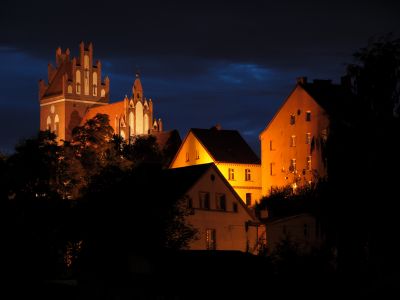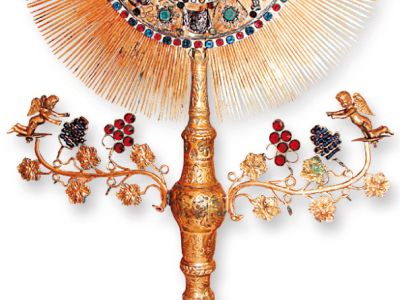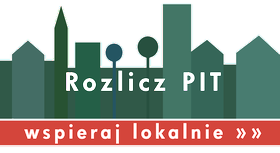Miasto i Gmina Gniew
Menu witryny
Treść strony
St. Nicholas Church
The most important monument located just by the market on Kościelna street is the parish of Gniew – St. Nicholas Chuch, the patron of sailors and merchants. Apart from the Teutonic castle, it is the most monumental building of the city, dating back to the medieval period. The wooden chapel has existed in Gniew most probably before the castle was taken over in 1282 by the Teutonic Order.
The foundation act of 1297 mentioned “...Ecclesiae parochiali...” the so-called parish church, which was equipped with four drags of land exempt from levies and weighs. The construction of the present church was begun in the mid-fourteen century. First, the chancel was built. Construction work associated with the body and tower lasted until the mid-fifteenth century. The plinth of the church consists of massive granite slabs.
Most of the equipment of the temple dates from the second half of the XIX century. There are also objects of longer pedigree – Baroque chasuble dating from the fourth quarter of the XVII c., which according to the local tradition has been offered to the parish by Queen Maria Kazimiera Sobieska.
Also the monstrance made by Krystian Schubert II – the Gdansk goldsmith, is dated back to around this period, one of the most valuable ones in this part of Poland, with the glory in the shape of the sun and six-leaf leg, which has god badges with the scenes from the life of Christ.
In one of two side aisles, called the Radziwiłł chapel, from the surname of its probable founder, Stanislaw Albrecht Radziwiłł – the governot of Gniew, there is an altar of St. John Paul II.
Since 2009, the church in Gniew and the churchyard area is the land of the regularly conducted archaeological studies, as a result of which, among others, the largest Polish collection of silk clothing has been discovered, as well as mass graves, countless coins, and the remains of the earlier pagan temple. Thanks to the work of archaeologists it has become possible to make the crypt available, which has exposed some of the finds to the people visiting it.
The bell on the church tower comes from the XVIII century, which bears the name of the temple’s patron. The mantle of the bell has got an inscription placed by the bell-founder: “I have been born by the pious generosity of the foundations of the Church”.
The most deserved for the Gniew parish priests included father Benon Kursikowski (1831–1903) – parish priest and dean of Gniew and the social activist, who has, among others, conducted the renovation of the cemetery chapel, the church and who has rebuilt the church tower, and father Władysław Piaskowski (1913–2008) – the first post-war parish priest, who has renovated the sanctuary largely damaged by a cannon ball, as well as he has organised the first post-war parish mission.
Polecamy
Dofinansowanie
Strona sfinansowana została ze środków Ministerstwa Administracji i Cyfryzacji, w ramach konkursu na budowę strony internetowej oraz dostosowanie jej do potrzeb osób niepełnosprawnych.
Kontakt

Urząd Miasta i Gminy Gniew
Plac Grunwaldzki 1, 83-140 Gniew
pon., wt., czw. 7.30-15.30
śr. 7.30-17.00
pt. 7.30-14.00
tel. 58 530 79 19;
fax 58 530 79 40
e-mail: sekretariat@gniew.pl
DANE DO FAKTURY
Gmina Gniew
NIP 593 10 05 516
REGON 191675296
Adres Elektronicznej Skrzynki Podawczej: /34gu04waml/skrytka






























